New perk: Easily find new routes and hidden gems, upcoming running events, and more near you. Your weekly Local Running Newsletter has everything you need to lace up! Subscribe today.
Last year, Jasmin Paris delivered one of the most thrilling moments Gary Cantrell has ever witnessed as a race director, and perhaps as a human being. She became the first woman to finish the daunting Barkley Marathons—with just a minute and 39 seconds to spare.
“Ah, it was amazing,” Cantrell, better known as Lazarus “Laz” Lake, says warmly while taking his daily walk around his home in the Tennessee woods. It’s a 6-mile circumvention that never leaves him a mile from his house.
Cantrell, whose sense of humor is so dry that you may not know he was joking if he didn’t punctuate it with a maniacal cackle that would scatter a herd of deer, is, in fact, not joking about Paris. As proof, he gives a 10-minute soliloquy about why it does her a disservice to say her finish was amazing because she is a woman.
Her courage, Cantrell says, was extraordinary. She knew she had to go out too fast for her, Cantrell says, painfully so, and maintain that for, hell, days. Four hours before the cutoff, she had to go even faster, he says in awe, covering the ground a half-hour faster than the winner. Even then, Cantrell had given up just before Paris came storming down the road and and finished with less than two minutes to spare.
He pauses, and then says, softly, “You loved to see it.”
This isn’t what you’d expect from the same old man who, nearly a decade ago, said that a woman wouldn’t likely ever finish the Barkley Marathons. He said it with glee and threw in that they weren’t tough enough to do so. This was how Cantrell introduced himself to much of the world, and a good portion, ones who believe the Barkley is the kind of fun you’d get from dipping your toes in a jar full of scorpions, still haven’t forgotten.
They see Cantrell as a mad scientist who created the world’s toughest race to torture people. He wants to see people in pain, they say, and no doubt loves it when they fail.
But this is not how the people who have spent time with him see him, even the ones he’s tortured in the past.
“People look at him as this cruel sadistic person,” says John Kelly, three-time finisher of the Barkley Marathons and one of the leading experts on the race. “But he wants nothing more than to see people succeed.”
When anyone does, Cantrell remains flabbergasted by the achievement, mostly because it’s still a rare feat, even with an unprecedented five finishing this year. Only 20 different people have finished the race since it began in 1986.
But he also takes pride in the fact that nearly all do not finish and nearly all suffer along the way. The Barkley, and his other wildly popular creation, Big’s Backyard Ultra—a race in which runners complete a 4.167-mile loop on the hour, every hour, until there’s just one runner left—are designed to push people to the very limit of their being. These people want the impossible, but not quite, Cantrell says.
For Kelly, this dark desire was, indeed, part of his reasoning for entering the Barkley Marathons.
“People who do the Barkley,” Kelly says, “aren’t there for kudos on Strava.”
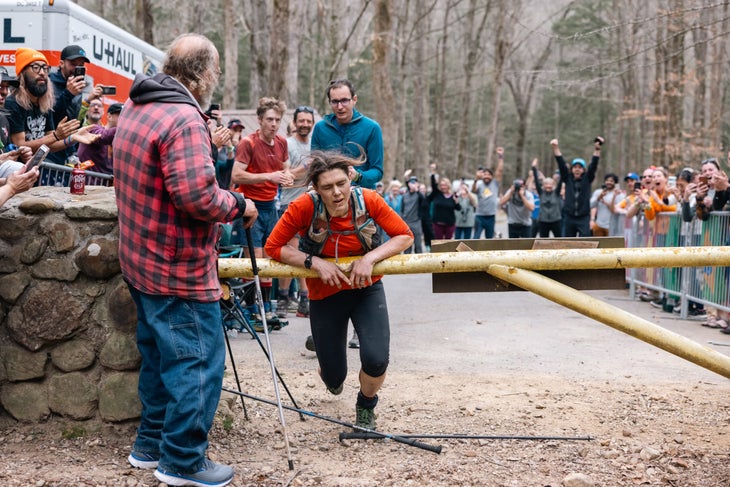
Thorny hills that demand twice the elevation gain of Everest, over 120 or so miles, often in miserable weather, on an unmarked route unrecognizable to the naked eye, with a five-loop cutoff of 60 hours, the Barkley Marathons does the trick.
“On that fifth loop, the runners have no business making it,” Cantrell says. “If it was a regular race, you’d pull them off the course. But in the Barkley, you say, ‘Yeah, he’s in pretty good shape.’”
Even today, Cantrell stands by the reasoning behind his comments about women finishing the course: on average in 100-mile races, top women perform 12 percent slower than top men. And on a course where the only finishers, if any, generally cross the line with less than an hour to go, there isn’t 12 percent to spare. (A 12 percent margin on a 59-hour finish is more than 7 hours—6 hours behind the 60-hour cut-off. In March, Paris finished in 59:58:21, just 1:39 under the cutoff.) After all, most years, there are no finishers, men or women, at all. But there was another reason he made those comments, he admits. He did wonder if, in fact, there was a female who could prove him wrong.
“And I knew that the person who could,” Cantrell says, “was exactly the kind of person who needed to hear those words.”
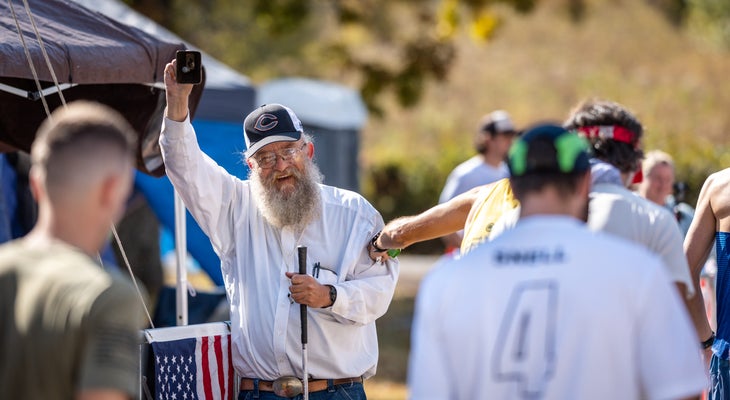
The Allure of the Daily Grind
Decades before he became “Laz,” Cantrell was a 12-year-old Boy Scout who got his first introduction to suffering on a backpacking trip. He’s been through a lot in his 70-or-so years—he doesn’t like to give his exact age—but he still remembers just how miserable those trips were. Mostly, he says, because of his inexperience dealing with the elements, both physically and mentally.
“You go through a lot of discomfort at first,” Cantrell says. “But I started out knowing nothing. They were so miserable because of what I didn’t know.”
The first running boom hit that same year, and he would follow his father down to a high school track, where dad ran a mile with his friends on most nights. Cantrell quickly became faster than his father, and he liked that feeling. It was the only impressive athletic thing his 70-pound frame could do.
He fell in love with running, however, because it demanded daily work to get better. Even as a boy, Cantrell loved to grind. It’s something he’s needed well into his adult life, even after he had to stop running because, he says, after putting well over 150,000 miles on them, “my legs are pretty beat up.”
“The warranty ran out at 100,000.”
The pain does not stop him from walking for two hours per day, or sometimes three, around his remote property in Bell Buckle, Tennessee. He has circulation issues, he says, and the walks keep the blood flowing. He also knows he needs the time outside for his head as well as his heart.
“I’m not a day off kind of guy,” he says. “I really think getting outside every day makes you a happier person.”
Cantrell did have some success as a runner: He ran his first marathon in 1975 (he thinks)—fast enough to qualify for Boston, though he never went. He discovered ultrarunning mostly because he began running farther than 26 miles in training to eliminate the so-called “wall” that plagued him after mile 20. When it worked, he was intrigued: The grind, it seemed, continued to pay dividends, and he wondered how far it could take him. In 1979, he ran his first ultramarathon, a 41-miler. There were 22 competitors in the race. Only three had run an ultra before.
“A lot of courses back then were designed around what people thought was the distance of a course,” Cantrell says. “So it was kind of a guess.”
This ‘go-run-on-a-trail-somewhere’ mentality helped develop Cantrell’s mad desire for possibilities. There were no ultramarathons in Tennessee at the time, and the Western States 100 was just two years old. So if Cantrell wanted to challenge himself by running long distances, he had to host the races himself. He couldn’t travel very far. He had a job as a bookkeeper and was a husband and father, and money was tight, even if his wife, Sandra, did well as a bookkeeper herself. So in addition to putting on race after race, he and his friends came up with journey runs, or cross-country jaunts from, say, Knoxville to Nashville. Cantrell’s inability to resist the grind stretched into a 500K across Tennessee: It is now the Last Annual Vol-State Road Race, his first gift to ultrarunners, with no aid stations or shelters and a cutoff of 10 days.
Cantrell may seem like a tortoise, and a lame one at that, but five years ago, he finished an 1,800-mile trek that took him 27 miles a day and four months to finish. Even now, the world’s best respect his ability to just keep going, a gift, they say, that epitomizes his contradictions.
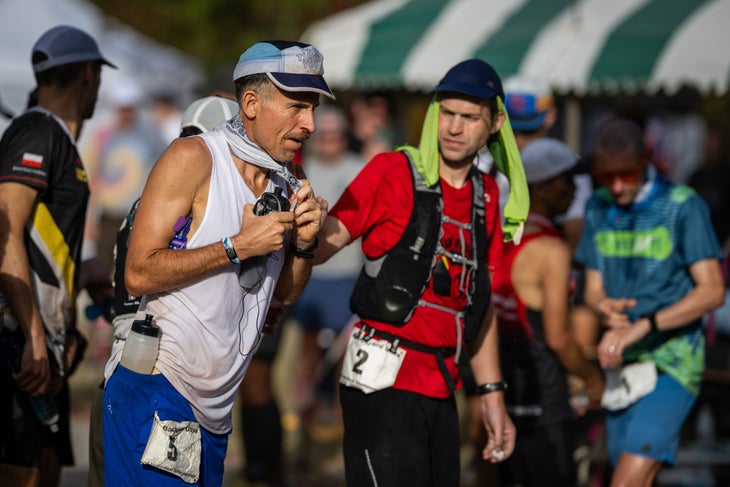
“He smokes and drinks Dr. Pepper all day and has a bit of a belly,” says Cincinnati-based ultrarunner Harvey Lewis, who won his second Big’s Backyard Ultra last year by running 450 miles in 108 hours. “But he can walk farther than anyone I know his age.”
Cantrell never kept track of his races, so he doesn’t know how many he’s done. That’s not the point. He is a bit of a philosopher and will wax poetic at times, but he prefers a simple explanation for his love for challenging himself, and others, with such long journeys: “How can you not?”
But it could come down to those days as a 12-year old shivering in the Tennessee woods near Frozen Head State Park, where he now holds the Barkley. That 12-year-old did adjust and even learned to love the discomfort.
“I learned that if you keep going,” Cantrell says, “it gets better.”
The Barkley Marathons Begins
In 1985, Cantrell was in his early 30s when he and a backpacking buddy nicknamed Raw Dog (who loves declining interviews) were greeted by two park rangers at the start of a planned journey into Frozen Head State Park deep in northeast Tennessee.
The park was in its early stages of what a normal human being might call recreation. It was even more foreboding then, and the most interesting thing about it was the faint trails that took hikers up some of the worst terrain on earth, with names like Big Hell, Rat Jaw, Bird Mountain, the Bad Thing, Son of a Bitch Ditch, and Leonard’s Butt Slide, a 45-degree hillside that plummets several hundred feet into mud and thorns that could guard a demon’s castle. Some of the trails hadn’t been maintained since the 1930s, and only the mountain people, those who lived way back there, could walk them without a map. Cantrell, of course, loved it.
The rangers were unfamiliar with Cantrell’s ability to grind and basically told him not to go in there. People got lost, they said, or hurt, or usually both.
“They told us, ‘Everyone who has gone up there, we have to go get,’” Cantrell says. “But I’d been doing those my whole life.”
It took him and Raw Dog a full day to walk nearly 8 miles, both because the terrain was awful and because he had to focus on the map constantly or else the trails they took disappeared from sight. Even today, the park would have been a great setting for the supernatural horror film “The Blair Witch Project.” Cantrell’s brain began churning.

“The first Barkley loop was discovered,” Cantrell says. “Although I don’t think we really discovered the Barkley. It was always there.”
At the time, trail running had just started to emerge as a (somewhat) mainstream sport. Cantrell was already disgusted with it.
“These people were running 6:50-minute miles on trails,” Cantrell says. “When I think of trails, well, that’s just not possible. Those weren’t trails. They were PATHS.”
He wanted to put on a real trail race, an adventure, a journey so hard that finishing wasn’t the purpose, or even necessarily possible. He took the loop he and Raw Dog did and added some spice, configuring a looped 50-55-mile course with about 24,000 feet of climbing. He mostly ignored the state park trails and used old logging trails, game trails, and faint social trails forged by locals.
Ed Furtaw thought Ultrarunning Magazine had misprinted the elevation gain when he saw the listing for the Barkley Marathons in its event calendar in 1987. Surely they meant 2,400 feet. And yet, later that year, he was talking to Cantrell in the hallway of a hotel before a 50-mile ultra the two were racing when Cantrell proudly pulled out a map of the state park and told Furtaw to look at the elevation lines. “Oh, my gosh,” Furtaw whispered. It really was 24,000 feet.
Even so, no one had finished the race in its first two years, or even came particularly close. It had a 24-hour time limit. Furtaw could run a 50-miler in eight hours. How hard could it be? Cantrell, excited that someone had a shot to finish, invited him and a couple other elite runners out to scout the course. Furtaw came up with the idea of using pages out of a book as proof they ran the right course, as it was so hard to follow that Cantrell wasn’t sure runners were successfully navigating it.
In 1988, in its third year, Furtaw became the first Barkley Marathons finisher and “Frozen Ed.”
The next year, Cantrell, who now deemed the course too easy, changed it to 100 miles.
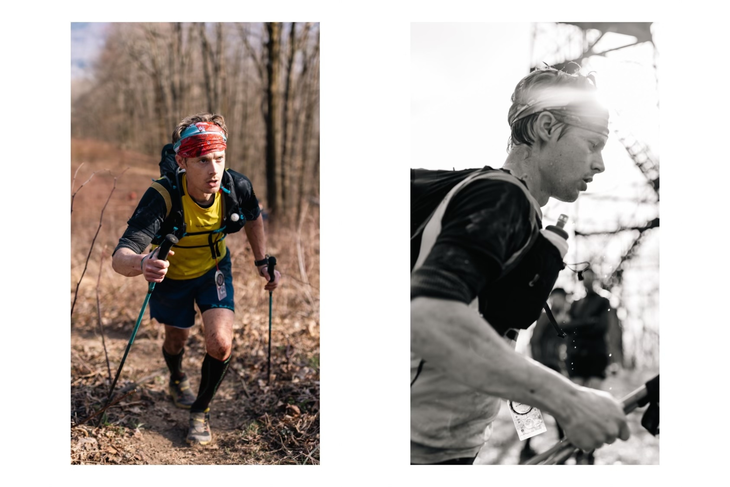
A Mad Genius
Furtaw does not think his longtime friend enjoys watching people suffer. He’s not a sadist. Being a sadist, Furtaw says, would be too easy for Cantrell.
Anyone could think of a race that would be impossible to finish, Furtaw says. A mile race with a cutoff of 3 minutes would do it. But that’s not Cantrell’s intention: He doesn’t want to see people fail.
Cantrell, instead, created a 120-or-so-mile race with typically rotten weather, on soft hills that collapse under footfalls, on terrain so steep that one slip means you’re sliding on your butt, on a course that is never exactly the same every year and requires the mental stamina to follow a map and find hidden books, on trails that vanish the moment you step off them, all in 60 hours, with a start time of whenever Cantrell fucking feels like it. To make it even harder, Cantrell calls the third loop a “fun run,” an incredible accomplishment for anyone, just to tempt those who have an actual shot at finishing into quitting and feeling good about it. He taunts those on their last lap, saying things like, ‘Well, this is a formality now,’ as if he was a spectator yelling ‘You’re almost there!’ when you’ve still got three miles left in a marathon.
And yet, the Barkley Marathons is doable. People have finished.
“He’s created something that is just hard enough,” Furtaw says. “He’s a genius. He’s an absolute genius.”
Cantrell’s influence on the sport can’t be understated, Kelly says, and has helped prevent ultrarunning from becoming a tiresome exercise of running long distances over the mountains and through the woods.
“He’s been the biggest innovator in our sport,” Kelly says. “So many race formats are directly from him or inspired by him.”
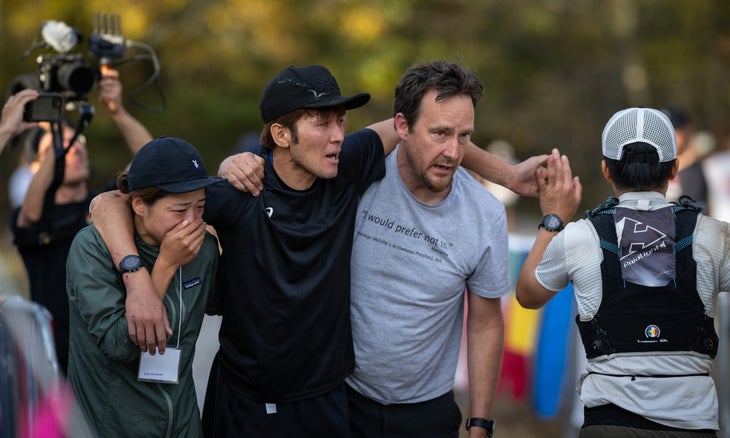
His imaginative races have also brought new people to the sport: More than 500 backyard-style ultras now exist all over the world, many of them run by people who wouldn’t ever think they could finish an ultramarathon. Yet the Barkley remains unique in a sport that loves to punish its participants but—in the name of mass participation and profit—offers races with generous cutoffs that allow people to walk most of the way. Cantrell doesn’t decry those races. He remembers the early days when anyone over age 45 couldn’t make the cutoffs. A 100-miler with a cutoff beyond 24 hours was considered crazy. Now, anyone healthy enough and spirited enough to suffer can run an ultra, no matter their age.
“It’s nice that there are races out there where you don’t have to be a world-class athlete,” Cantrell says.
But, by design, the Barkley isn’t that race, at least not for someone who may finish all five laps. Cantrell calls those people the one percent of the one percent, and it’s his job to give them the challenge of their lives. Still, Cantrell doesn’t want the Barkley to be just for those people. Every year, he welcomes runners of varying abilities, even those who would feel pretty damn good about finishing one lap. Cantrell can push those people to near-death experiences, too.
It’s hard to get into the Barkley, nearly impossible, just like the race. In fact, no one is really sure how to get in, other than that everyone has to write an essay. Cantrell says those are still important, as that’s how he picks the competitors. He varies the competition and limits the field in part because he doesn’t want 40 elite runners trampling all over the grounds trying to finish.
“I’ve come to see the Barkley as a spokesman for wilderness areas,” Cantrell says. “We want to give as many individuals as possible a chance to experience a run where you leave all your electronics behind for two-and-a-half days. It’s you against the wilderness.”
It makes you wonder, then, what on earth Cantrell has in store for next year’s Barkley after five finished this year, including the first woman. It was a glorious moment in Cantrell’s life, but does that mean the course is too easy now? Is he fulfilling his life’s mission? Does he need to take a chainsaw and down trees all over the course? Encourage the wild boars to chase the runners?
“Bah,” Cantrell says in response. That was just a rare weekend of perfect weather. Frozen Head won’t let him down again.
“As we were packing up after the race, it started to rain,” Cantrell says. “And it rained for the next 12 hours. Most of it hard. Had that happened during the race, we probably would have only had one finisher.”
“Oh, Sure, He Can Be Cranky.”
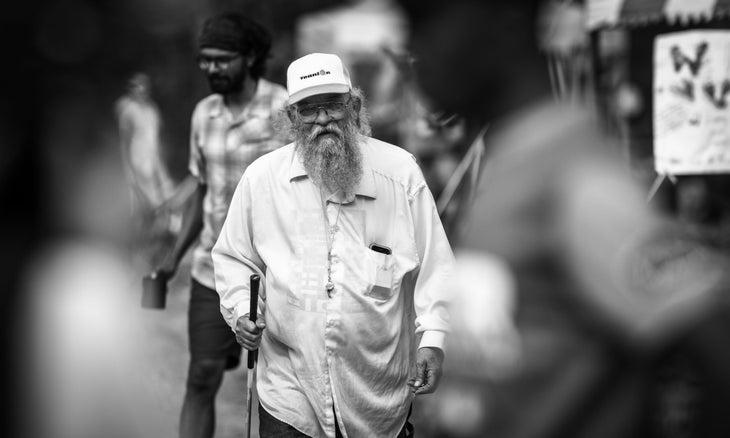
Sandra Cantrell doesn’t understand why anyone would think of her husband as a sadist. He simply loves offering people a challenge. In fact, as hard as the Barkley is, Sandra believes he would relish the challenge himself.
How can you not?
“He would love it,” Sandra says.
He’s talked about doing another long journey, maybe even the 500K Vol State again, Sandra says, but who knows if that will happen.
He is a little misunderstood, she says, but he’s also too old to care. Both of them are.
“Cranky? Oh, sure, he can be cranky,” Sandra says. “But he just enjoys putting on the races so much. They’re our family now.”
If Cantrell does flash that no-nonsense attitude during a race, or taunt the participants (he’s known for presenting a Staples “That was easy!” button to Barkley finishers and having them press it as they cross the line and collapse), it’s all part of his complicated personality, Kelly says.
“I’ve described him as the exterior of a badger and the heart of a golden retriever,” he says.
Lewis found himself taken, even entranced, by Cantrell’s magnetic personality during his first time at Big’s Backyard. He doesn’t think the event would be nearly as successful without Cantrell.
“He’s certainly a special individual,” Lewis says. “He’s really in this just because he enjoys it. What’s greater than that?”
It’s probably safe to say that the Barkley and Big’s Backyard Ultra could be much bigger than they are. If Cantrell was so inclined, he could probably sell the rights to a big corporation that could hold the event, at least Big’s, in a stadium. At the very least, he wouldn’t have to pull his rotting teeth himself (13 so far) to avoid dentist fees. But progress doesn’t interest Cantrell. He loves talking to people on his daily walks, but he also wants them far away from his house, where he’s lived since 2010.
“We lived on Union Ridge for 35 years, but it got to where you could stand on your front porch and see two or three houses,” he says. “You can’t live like that.”
The city approaches, Cantrell says, “like a cancer,” and now their biggest fear is that Frozen Head will grow. He’s heard whispers about the state putting in an RV campground. Rangers have told him it won’t happen. Cantrell remains cynical.
“The government thinks all state parks must be identical,” he says “and once you get in these RV people, they will start crying out for roads. If it gets to that point, the Barkley won’t be the Barkley anymore.”
He has, quietly, handed off some of the Barkley responsibilities to others with more time and energy, though he remains in charge. Registering and monitoring all those backyard ultras has taken a lot of his free time, and he doesn’t have the body to take care of the Barkley course any longer.
“I had to take a chainsaw and lug it up the trail to prepare the course,” Cantrell says, “and my back has suffered from a lifetime of that. My muscle mass has decreased.”
But he’s not ready to sit on the couch yet. In April, Cantrell attempted to walk across America. Starting in Delaware, he walked for 126 days and a total of 1,700 miles before stopping his journey short in Foyil, Oklahoma, the town where his father grew up.
“Yesterday, he made it to his parents’ graves,” author, ultrarunner, and one of Cantrell’s crew members Jared Beasely wrote on Instagram on June 22. “In the increasing heat, it became an obsession.”
Cantrell will grind away at it as much as he can, but, like for us all, the passing of time remains his toughest race.
